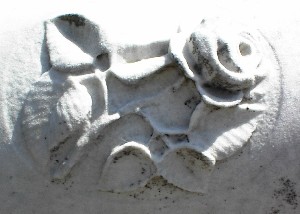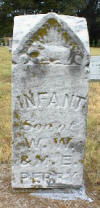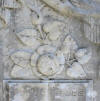 d lambs, labeled "Infant son" or
"Infant daughter."
d lambs, labeled "Infant son" or
"Infant daughter."Sentiments in Stone
By Kristin Eoff

"I hope to meet with thee again in yon bright world above."
Wreathed in vines and decorated with roses and lilies, the weathered headstones of ages past still haunt us today.
Walking along the undulating paths of oft-forgotten old cemeteries in the United States, a visitor can catch a glimpse of the Victorian love of romance in the carved stones of yesteryear.
Bearing witness to years of wind and rain, they transmit their silent messages of love and mourning, telling of beloved mothers, fathers and children who perished in body but not in spirit. Far from being frightening places to visit just on Halloween, old cemeteries today are cherished hideaways for peaceful reflection and nostalgic memories, just as they were when they were established years ago.
"How desolate our home, bereft of thee."
 Click pictures to view full
size
Click pictures to view full
size
Particularly poignant, especially to the mother of any young child today, are
the many headstones ornamented with sculpte d lambs, labeled "Infant son" or
"Infant daughter."
d lambs, labeled "Infant son" or
"Infant daughter."
Despite new advances in medicine, the Victorian age still saw high child-mortality rates from diseases and accidents so avoidable today. Despairing parents mourned their lost children with tender sayings such as "In heaven there is one angel more" and "Our little May sleeps sweetly here."
 Lovely headstones were an expression of grief and affection and often were
the only tangible reminder of young lives cut short much too soon.
Lovely headstones were an expression of grief and affection and often were
the only tangible reminder of young lives cut short much too soon.
"Prepare to meet me in heaven."
Inscriptions such as these tell of the sorrows and hopes of families who yearned to see their loved ones again someday. But carved headstones were merely one way for Victorians to mourn their dead. Also popular during this age were jewelry and pictures made from the deceased person's hair, as well as new photos of the dearly departed.


When her adored husband Prince Albert died in 1861, Britain's Queen Victoria (1819-1901) fell into deep mourning, donning black, entering seclusion for five years, and setting the styles of mourning rituals throughout Britian and the United States.
Shortly afterward, the United States was plunged into its Civil War (1861-1865), and mounting casualties made mourning a serious preoccupation for Americans. Advice books and etiquette manuals prescribed the proper way to mourn lost loved ones.
Before funeral parlors were widespread, a body was laid out in the family home, with flowers wafting their sweet scent throughout the house. Black fabric was hung over windows, and black wreaths were hung on doors.


The Web site "Civil War and Mid-Victorian Mourning Rituals" states that "Before the rural cemetery movement of the 1830's, graveyards were considered undesirable places for the living to visit. Churchyards and family plots were becoming overcrowded and unsanitary. For this reason, large rural cemeteries were created on the outskirts of towns. The idea of public cemeteries spread quickly. They were designed like parks, making the visit a pleasing experience. Benches, paved paths, gardens, ponds and fountains were added to give a serene setting to those wishing to mourn or meditate."
"Gone but not forgotten."
The Victorian age, spanning the years of Queen Victoria's 1837-1901 reign, saw amazing progress in science and technology. Yet despite this, often the most enduring legacy for many historians and descendants is the family churchyard, where generations of loved ones lie buried beneath touching tributes to their lives and accomplishments.

While antique clothing may decay, and old photos may fade away, solid stones of granite and marble remain for years to tell of lives both long and short. Unequaled are they to genealogists seeking clues to ancestors, and to schoolchildren learning about the histories of their communities.
Popular headstone designs in the Victorian age included doves, Heaven's gates, clasped hands, crosses, open Bibles, hearts, urns, flowers, Masonic emblems and nature motifs.
Members of the fraternal order Modern Woodmen of America, established in 1883, frequently chose headstones resembling tree trunks covered with bark and intricate ivy, crossed wood axes at the ready. The Modern Woodmen acquired their name not by a woodcutting occupation but by a sincere wish to emulate "the work of the pioneer woodmen clearing away the forest" and thus prepare themselves for prosperous futures.


 Many of the motifs on Victorian gravestones possessed multiple layers of
meaning for their viewers steeped in classical literature and Biblical sermons.
Angels evoked heavenly guardians and hopes for resurrection, while corn bespoke
of a long, full life, and doves represented a soul's reaching peace in heaven.
Ivy attested to undying affection, and innocent lambs recalled youth and purity.
Weeping willows, of course, symbolized mourning.
Many of the motifs on Victorian gravestones possessed multiple layers of
meaning for their viewers steeped in classical literature and Biblical sermons.
Angels evoked heavenly guardians and hopes for resurrection, while corn bespoke
of a long, full life, and doves represented a soul's reaching peace in heaven.
Ivy attested to undying affection, and innocent lambs recalled youth and purity.
Weeping willows, of course, symbolized mourning.
In some cemeteries, periwinkle, or myrtle, is still found growing, in a reflection of a Scotch-Irish custom of throwing sprigs of myrtle on graves.
Victorians loved opulence and sought their inspirations for the decorative arts in many eclectic sources. Obelisk gravestones hearkened back to Egypt, while ornate mausoleums often featured classical Greek columns. Gothic arches also were used.
After the 1920's, Victorian designs gave way to Art Deco. Headstone designs changed and yielded to a simpler appearance. Yet the graveyards of yesterday still speak to us today, if we only will take the time to listen.
All photos taken in Carrollton, Texas, by Kristin Eoff.
Bibliography
http://cr.jour.sc.edu/archive%203-29-20/CEMETERY2.htmlhttp://etd02.lnx390.lsu.edu/docs/available/etd-1102103-142417/unrestricted/10Chap3_Victorian_Tombstone.pdf
http://olivetreegenealogy.com/misc/grave_symbols.shtml
http://www.ancestry.com/learn/library/article.aspx?article=151
https://www.angelfire.com/pa4/mourning/
http://www.bbc.co.uk/london/yourlondon/unitedcolours/cemeteries/victorian_memorial_symbols.shtml
http://www.columbian.com/lifeHome/lifeHomeNews/06282005news2053.cfm
http://www.gatherings.info/about/who.asp
http://www.post-gazette.com/pg/04179/337086.stm
http://www.sfgate.com/cgi-bin/article.cgi?file=/chronicle/archive/2001/06/08/NB198038.DTL